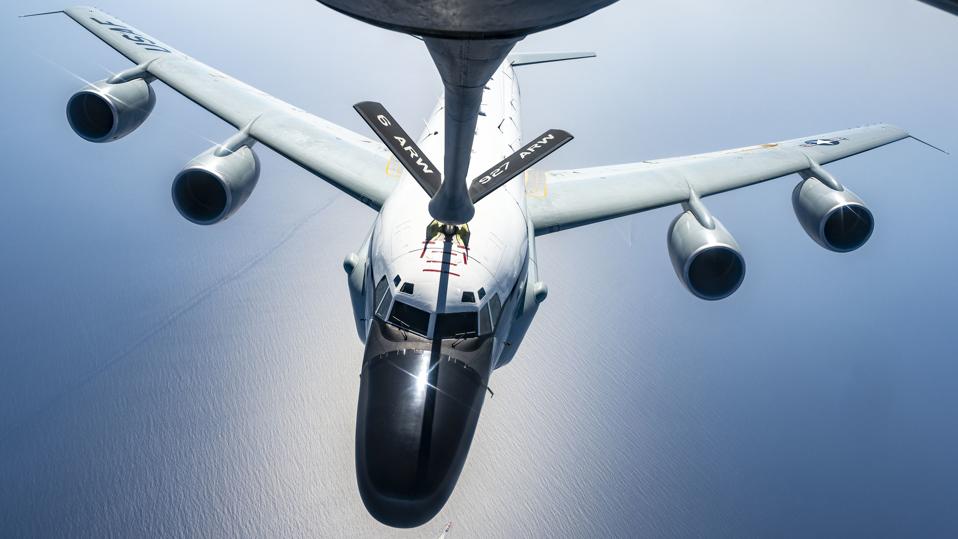
The U.S. Air Force has begun ripping the electronic-warfare gear out of its aging, propeller-driven EC-130H radar-jamming planes and installing it on much newer—and faster and higher-flying—EC-37B jets.
The work that contractor L3Harris is doing on the 11 EC-37Bs could be a model for replacing other Air Force special-mission planes—in particular, the 17 RC-135V/Ws that are among the oldest, and busiest, planes in the USAF fleet.
But it’s not clear the Air Force wants a direct replacement for the four-engine, jet-propelled RC-135. It’s possible a secretive new drone has sucked all the urgency out of the problem.
The USAF has lots of old planes. Sixty-year-old B-52 bombers. Forty-year-old C-130 transports. Hundreds of F-15 and F-16 fighters in their fourth decade of service. But the RC-135s stand out.
Converted from early-1960s-vintage C-135 transports, the 17 RC-135s are special not only for their age, but also for their importance—and for the absence of any clear plan to recapitalize them.
The RC-135s, also know as “Rivet Joints,” are electronic-intelligence aircraft. While permanently based at Offutt Air Force Base in Nebraska, the Rivet Joints spend most of their time forward-deployed to Japan, the United Kingdom and the Middle East, from where they surveil Chinese, Russian and Iranian forces, scooping up electronic signals in order to locate and characterize their air-defenses.
The R.J.s’ missions are so important that the Pentagon considers them “national assets.” They don’t just work for the Air Force or even the military as a whole. The intelligence they gather often flows directly to intelligence agencies and the White House.
The RC-135s fly in international air space, often with their transponders on, meaning they’re not hard to track. Practically every day at least one RC-135 is flying some strategic mission somewhere.
Still, there’s no plan to make sure the Rivet Joints’ mission doesn’t end when their airframes eventually wear out, whenever that might be. The Air Force once vaguely entertained the notion of replacing the RC-135s with a new 767-based multi-mission place called the E-10. But the E-10 fell victim to cost-cutting in 2006.
The Air Force’s ambivalence toward the Rivet Joints doesn’t apply to the service’s other aging plane types. The B-52s are getting new engines, sensors and weapons. There’s a new C-130 model in production. Factory-fresh F-35s and F-15EXs slowly are replacing the oldest F-16s and F-15s.
It’s not like the Air Force is rebuilding or replacing every other old plane in its inventory, of course. The service decided the ground-surveillance mission that the weary E-8 Joint Surveillance Target Attack Radar System performs has become too dangerous for a big, slow plane.
Instead of directly replacing the JSTARs, the Air Force is developing ground-surveillance satellites as well as a new data-sharing network allowing stealth fighters to share data on ground targets.
If there are new alternative technologies that could supplant the RC-135s, they remain closely-held secrets. It also is possible the Air Force instead could do what it’s doing with the EC-130, and pay L3Harris to install the RC-135’s ELINT gear on a newer, better-performing airframe.
But no, it appears the Air Force is going to just keep operating the RC-135s ... indefinitely. Indeed, the flying branch all but committed to keeping the Rivet Joints at least for another 10 to 15 years when it agreed to help support the Royal Air Force’s own RC-135s.
The RAF bought three RC-135s back in 2010 in order to replace Nimrod surveillance planes. L3Harris took three USAF KC-135R tankers, removed the refueling gear and installed the ELINT systems. The result was a batch of “new” RC-135s.
The RAF plans to fly its RC-135s through the 2030s. If the USAF were to get rid of its own, much larger RC-135 fleet before then, the British ELINT jets would become much more difficult to support.
So it’s reasonable to expect the Rivet Joints to keep doing what they do for another couple decades.
Which is not to say they will remain unchanged. L3Harris frequently updates the planes’ receivers and processors in order to keep pace with ever-improving enemy air-defenses. Their cockpits get regular upgrades, too. The Air Force in the early 2000s replaced the original TF-33 engines with newer CFM-56s.
An RC-135’s basis structural components might be 60 years old, but the rest of the plane is as young as just a few years.
That said, internal updates don’t make the lumbering Rivet Joints any less vulnerable. That’s not necessarily an issue during peacetime, when an RC-135 stays in international air space. If an enemy fighter intercepts a patrolling Rivet Joint, the ELINT plane’s crew just plays it cool.
But Rivet Joints have a wartime mission, too—keeping track of enemy air-defenses and relaying their locations to U.S. and allied forces. It’s that mission that’s in jeopardy as enemy defenses grow more sophisticated while the R.J.s stay pretty much the same.
It’s a safe bet that the USAF has thought through that problem. The service has begun deploying a high-flying stealth drone called the RQ-180. It’s possible the RQ-180 can collect electronic intelligence.
That doesn’t make the drone an RC-135. One of the advantages of sending a manned plane to collect ELINT is that the on-board crew can analyze signals immediately and on its own. No need to send the data somewhere else.
A drone can’t yet fully replace an RC-135. But RQ-180s could help to fill any intelligence gaps that might result in wartime, if and when enemy missiles compel the old Rivet Joints to pull back from the front line.
That might help to explain whey the Air Force isn’t in a hurry to acquire a new, potentially more-survivable ELINT plane.







